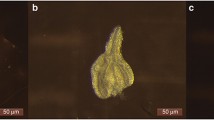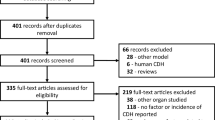Abstract
A spectrum of tracheo-oesophageal malformations is seen in humans: oesophageal atresia, tracheal agenesis and laryngotracheo-oesophageal clefts. They are thought to share a common but unknown aetiology. These birth defects are frequently associated with other VACTERL anomalies. The adriamycin rat model (ARM) has proved to be a valuable model of the VACTERL anomalies, illustrating the dysmorphogenesis of oesophageal atresia and tracheal agenesis. As organogenesis relies on temporaspatially co-ordinated signalling systems, the next step would be to study the molecular pathogenesis of tracheo-oesophageal malformations. However, the mouse is the foremost mammal studied by developmental biologists, offering an expanding wealth of knowledge and scientific research techniques with which to investigate these anomalies. A limited dose response analysis of the teratogenicity of adriamycin in the mouse has identified a dose and timing of injections that produced tracheo-oesophageal malformations and other VACTERL anomalies. A clear account of the types and variability of the tracheo-oesophageal malformations produced by this dose is essential in order to be able to plan and interpret any future investigations of early gestation fetuses. CBA/Ca mice were accurately time-mated (n = 10). Nine dams received intraperitoneal injections of adriamycin (6 mg/kg) and one control dam received saline injections, on days 7 and 8. Fetuses were harvested on day 18, near term. Tracheo-oesophageal malformations were examined by dissecting microscope and serial transverse sections. Results are reported in the standard teratological manner as mean percentage per litter (±SEM). The resorption rate of the adriamycin treated fetuses was 50.4%. There were 29 adriamycin treated fetuses for inspection. Tracheo-oesophageal malformations were found in 29.2% (±10.3), affecting five out of nine litters. Oesophageal atresia occurred in 15.6% (±8.1), laryngotracheo-oesophageal cleft in 10.4% (±7) and tracheal agenesis in 3.1% (±3.1). All of these malformations occurred with a tracheo-oesophageal fistula. Unlike the ARM, the AMM can produce fetuses with complete laryngotracheo-oesophageal cleft as well as oesophageal atresia or tracheal agenesis. Their occurrence was found to be reproducible but variable. These are important considerations when planning and interpreting experiments using this model.

Similar content being viewed by others
References
Dawrant MJ, Giles S, Bannigan J, Puri P (2005) Defining the extent of the adriamycin mouse model. CAPS 37th annual meeting, Québec City, 24 September 2005
Dawrant MJ, Giles S, Bannigan J, Puri P Adriamycin produces a reproducible teratogenic model of VACTERL anomalies in the mouse. J Pediatr Surg (in press)
Narotsky MG, Kavlock RJ (2003) In vivo assessment of prenatal developmental toxicity in rodents. Curr Protoc Toxicol 13.5.1–13.5.25
Ioannides AS, Chaudhry B, Henderson DJ, Spitz L, Copp AJ (2002) Dorsoventral patterning in oesophageal atresia with tracheo-oesophageal fistula: evidence from a new mouse model. J Pediatr Surg 37:185–191
Kaufman MH (1999) The atlas of mouse development. Academic, London
Diez-Pardo JA, Qi B, Navarro C, Tovar JA (1996) A new rodent experimental model of esophageal atresia and tracheoesophageal fistula: preliminary report. J Pediatr Surg 31:498–502
Qi BQ, Beasley SW (1999) Communicating bronchopulmonary foregut malformations in the adriamycin-induced rat model of oesophageal atresia. Aust NZ J Surg 69:56–59
Qi BQ, Beasley SW (1999) Pathohistological study of adriamycin-induced tracheal agenesis in the fetal rat. Pediatr Surg Int 15:17–20
Pole RJ, Qi BQ, Beasley SW (2001) Abnormalities of the tracheal cartilage in the rat fetus with tracheo-oesophageal fistula ot tracheal agenesis. Pediatr Surg Int 17:25–28
Tyler DC (1985) Laryngeal cleft: report of eight patients and a review of the literature. Am J Med Genet 21:61–75
Evans JA, Greenberg CR, Erdile L (1999) Tracheal agenesis revisited: analysis of associated anomalies. Am J Med Genet 82:415–422
Zaw-Tun HA (1982) The tracheo-esophageal septum–fact or fantasy? Origin and development of the respiratory primordium and esophagus. Acta Anat 114:1–21
Merei JM, Hutson JM (2002) Embryogenesis of tracheo esophageal anomalies: a review. Pediatr Surg Int 18:319–326
Mendelsohn C, Lohnes D, Dcimo D, Lufkin T, LeMeur M, Chambon P, Mark M (1994) Function of the retinoic acid receptors (RARs) during development (II) multiple abnormalities at various stages of organogenesis in RAR double mutants. Development 120:2749–2771
Litigung Y, Lei L, Westphal H, Chiang C (1998) Sonic hedgehog is essential in foregut development. Nat Genet 20:58–61
Motoyama J, Liu J, Mo R, Ding Q, Post M, Hui C-c (1998) Essential function of Gli2 and Gli3 in the formation of lung, trachea and oesophagus. Nat Genet 20:54–57
Minoo P, Su G, Drum H, Bringas P, Kimura S (1999) Defects in tracheoesophageal and lung morphogenesis in Nkx2.1(−/−) mouse embryogenesis. Dev Biol 209:60–71
Sekine K, Ohuchi H, Fujiwara M, Yamasaki M, Yoshizawa T, Sato T, Yagishita N, Matsui D, Koga Y, Itoh N, Kato S (1999) Fgf10 is essential for limb and lung formation. Nat Genet 21:138–141
Ohuchi H, Hori Y, Yamasaki M, Harada H, Sekine K, Kato S, Itoh N (2000) Fgf10 acts as a major ligand for Fgf receptor 2 IIIb in mouse multi-organ development. Biochem Biophys Res Commun 277:643–649
Mahlapuu M, Enerbäck S, Carlsson P (2001) Haploinsufficiency of the forkhead gene Foxf1, a target for Sonic hedgehog signalling, causes lung and foregut malformations. Development 128:2397–2406
Que J, Choi M, Ziel JW, Klingensmith J, Hogan BLM (2006) Morphogenesis of the trachea and esophagus: current layers and new roles for noggin and Bmps. Differentiation 74:422–437
Author information
Authors and Affiliations
Corresponding author
Rights and permissions
About this article
Cite this article
Dawrant, M.J., Giles, S., Bannigan, J. et al. Adriamycin mouse model: a variable but reproducible model of tracheo-oesophageal malformations. Pediatr Surg Int 23, 469–472 (2007). https://doi.org/10.1007/s00383-006-1847-9
Published:
Issue Date:
DOI: https://doi.org/10.1007/s00383-006-1847-9




